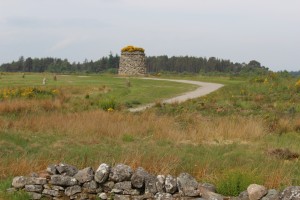The battle at Culloden was a struggle for power between Prince “Charlie” Stuart and the Duke of Cumberland, the grandson of King James II (of England and VII of Scotland) and the son of King George II, respectively. It was the last set-piece battle on English soil.
Afterwards, relatives placed stones showing where entire families fought as units within the greater Jacobite army (Prince Charlie’s). Additionally, stones meant to commemorate specific individuals were erected: these being the Well of the Dead, and the Cumberland stone. The graves of the 50-60 government soldiers who died fighting have not been found. They are honored with the English Stone.
Because this site has been marked out as culturally significant in Scottish history, it is of the utmost importance to preserve it, and by extension, the memory associated with the land. This is where archaeologists come in.
“Dog tags” were not invented until the mid-1800’s, so the identities of the people left behind must be determined by their belongings, commonly metal buttons and weaponry. The Jacobite army was constantly moving, so it restocked in towns on its way to Culloden. This resulted in an uneven array of weaponry and other surviving equipment.
The artifacts left on this site have been protected by the natural terrain, which merges into marshy land, and thick plant life, both of which work to prevent visitors from disturbing the grounds. This is important because when an artifact is moved, it loses its original context for the time in which it was first dropped/buried. Like many sites that have seen battle, or other traumatic experiences, it has gone into a period of abandonment. In this case, the restoration of the moor as a designated historical battlefield prevents other use, which will be apparent in the stratigraphic record (the study of how soil forms layers, and what time periods those layers are from).
A single object may tell us about itself, but its location (vertically and laterally) tells us about it in relation to other objects in the area (in a way that might form a pattern!). Together, they help us create a better picture of the past.
Archaeologists have used various methods (most common are surface survey, ground-probing radar, and metal detectors) to find the general layout of the battlefield. In addition to these surveying methods, primary source documents (old maps and journal entries!) are used to direct focus onto a specific area for fieldwork (historical archaeology).
This type of search, targeting a specific region within the battlefield is considered a biased survey. Excavations are performed when a site is in danger, in this case when the visitor center was built in 2007. Excavations may confirm the presence of certain features (such as buildings that are no longer present) that may help clarify previous research. In Culloden, buildings were burned to discourage further uprisings. This battle, like many others, can be explored through archaeological methods.
References/additional reading:
http://canmore.rcahms.gov.uk/en/site/14201/details/culloden+moor+battlefield/
http://www.wargravesheritage.org.uk/news.html
http://www.pasthorizonspr.com/index.php/archives/05/2008/the-archaeology-of-the-battle-of-culloden
http://data.historic-scotland.gov.uk/pls/htmldb/f?p=2500:15:0::::BATTLEFIELD:culloden
http://www.explore-inverness.com/what-to-do/attractions/culloden-battlefield/
Photo by Hanna Mitamura



You note in your post that a variety of sources exist about the battle at Culloden. I am curious about how primary documents function relative to knowledge of the material record at this site “marked out as culturally significant in Scottish history.” I would expect that these sources would be immensely helpful in informing where to look, what to look for, as well how to analyze what is found. In what other ways could these various sources compliment one another? Also, is it possible that these different kinds of sources could contradict one another? What different voices and authorities are represented in these different sources and to what effect? How can we form as complete and equitable understand of history as possible?
“Simple stones” marked graves long before the carving of formal grave markers from stone. This poses a problem for archaeologists and preservationists. Many cemeteries have been disturbed because the markers are not very different from the stones in the surrounding area. The Archaeology of Memory is a framework for research that tries to address how memories of the past influence what is left behind. To someone who attended the burial, a simple stone marker is all that is needed. To descendants who are told stories the stone marker may be enough. To their descendants, the stone marker may not mean anything.